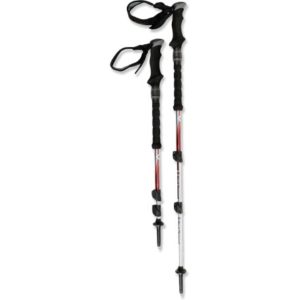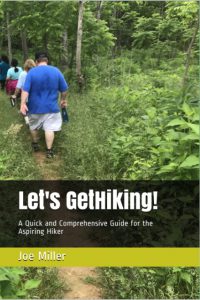In our ongoing effort to convince folks that trekking poles are a good idea, today we borrow Chapter 17 from our book, “Let’s GetHiking! A Quick and Comprehensive Guide for the Aspiring Hiker!” It makes our case for why you should use poles.
Years ago I was backpacking across Jane Bald on the Appalachian Trail when I came upon a 74-year-old hiker from Atlanta. We talked for a few minutes, mostly about his extensive hiking experience in the region. “Of course,” he said after sharing yet another “favorite” trail, “I wouldn’t be hiking any of them without these.” At that, he tapped the two hiking poles he’d been leaning into. “Wish I’d started hiking with ‘em seven years sooner. Would have spared my knees some pain.”

My new friend’s lament is a common one. All too often we put off using trekking poles because they’re perceived as being for “old people.” In fact, they’re for anyone who wants to spare their knees and other joints, and keep hiking late into life. Even a 39-year-old like Brian Terwilliger, who in 2013 broke the Ultimate Hike record for covering a 28.3-mile stretch of the Foothills Trail in 6 hours and 54 minutes. Despite being in phenomenal shape, Terwilliger wouldn’t have thought of attempting the record without his poles. “I love ‘em,” he says. “I’ll even use ‘em on a 5-mile hike.”
In addition to prolonging your hiking life, they also offer short-term benefits. According to a study out of Northumbria University in Newcastle, England, trekking poles help maintain muscle function while reducing soreness in the days following a hike. Study details follow:
The study: 37 physically active men and women were split into two groups. One group was issued trekking poles, given basic instruction on how to use them, and sent on a hike up and down 3,560-foot Snowdon, the highest peak in England. The other group marched up and down Snowdon sans poles. Heart rates and personal perceived exertion ratings were taken during the hike. Then, at 24-, 48- and 72-hour intervals after the hike, muscle damage and function were assessed.
The results: The hikers who used trekking poles reported significantly less muscle soreness, their loss of strength was less, and they recovered from the hike faster than their pole-free counterparts. While both groups reported some soreness 24 hours after the hike, after 48 hours the trekking pole users complained much less than the pole-less hikers. The people without poles also registered much higher levels of creatine kinase — an enzyme indicated muscle damage — 24 hours after the hike.
“The results present strong evidence that trekking poles reduce, almost to the point of complete disappearance, the extent of muscle damage during a day’s mountain trek,” said Dr. Glyn Howatson, who conducted the study. “These findings have particularly strong application for exercisers wishing to engage in consecutive days activity in mountainous terrain.”
Other reasons to use poles:
Navigating uneven terrain. Here in the Southeast, we have a lot of trails festooned with rocks, tree roots and other natural obstacles. Challenging enough when it’s dry, a veritable minefield when it’s wet.
Crossing creeks. We also have a lot of creeks, especially in the Southern Appalachians, that don’t have bridges. Not big creeks, most of them, but enough of a challenge that you either need to rock hop across them or actually get your feet wet. In either case, having three points of contact at all times gives you much better stability in a potentially dangerous situation.
Navigating spider-webbed trails. Especially in summer, especially if you’re hiking early in the morning, you’ll want trekking poles to wave in front of your face to clear the overnight construction work of the wild’s industrious spider community.
In a pinch … they can also be used to construct a splint in the event a non-pole-using hiker goes down and breaks a leg bone.
It boils down to this: You can either ditch the poles, look younger (in your own mind), and suffer the consequences spelled out above, or go faster and farther with less lingering soreness.
Your choice.
* * *
Let’s GetHiking!
 The 109-page “Let’s GetHiking! A Quick and Comprehensive Guide for the Aspiring Hiker,” covers the basics of getting started on the trail, from what to wear on your first hike to trail etiquette to the benefits of trekking poles. Learn more here.
The 109-page “Let’s GetHiking! A Quick and Comprehensive Guide for the Aspiring Hiker,” covers the basics of getting started on the trail, from what to wear on your first hike to trail etiquette to the benefits of trekking poles. Learn more here.
GetHiking! Southeast Podcast
 This week on the GetHiking! Southeast Podcast: Our 5 Favorite Group Campsites. Give a listen here.
This week on the GetHiking! Southeast Podcast: Our 5 Favorite Group Campsites. Give a listen here.
